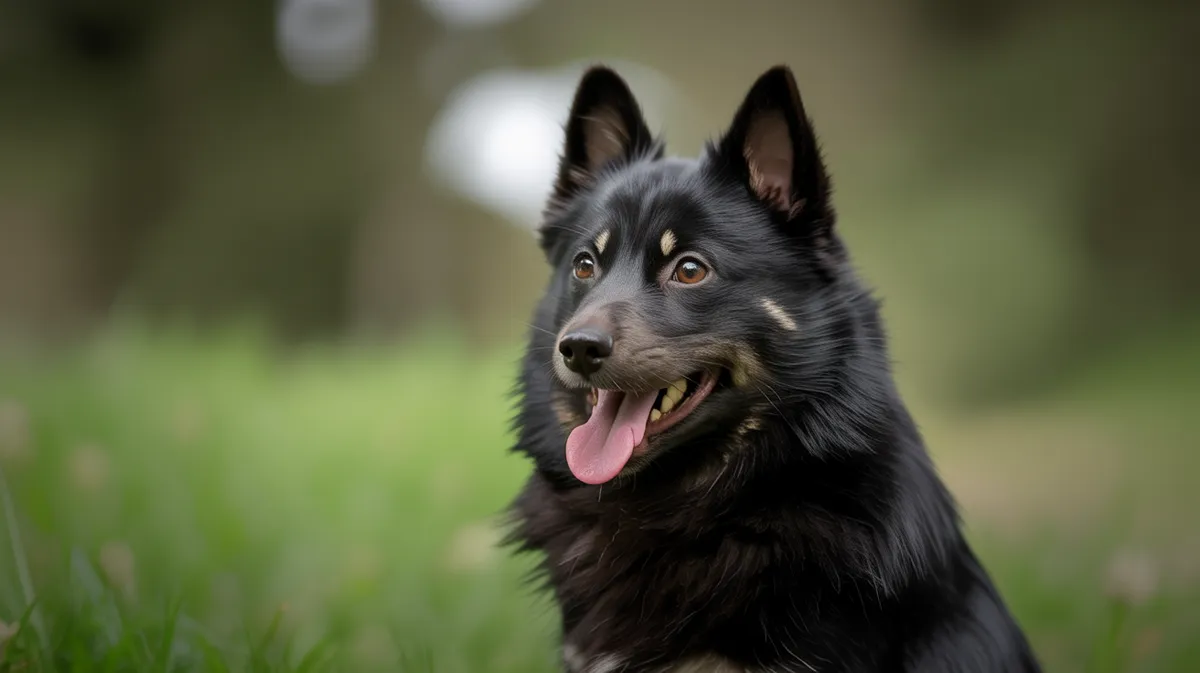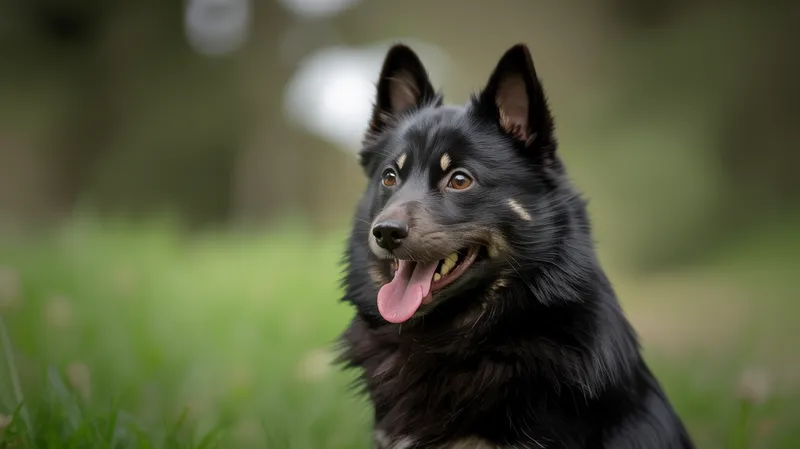
Schipperke
Canis lupus familiaris

Meet the Schipperke
The Schipperke is a small, fox-like dog breed originating from Belgium, prized for its lively personality and keen watchdog abilities. Known for its jet-black double coat, pointed ears, and distinctive ruff of fur around the neck, the Schipperke is agile, energetic, and highly intelligent. Traditionally used as a watchdog and rat-catcher on barges and farms, this breed is alert, curious, and often described as having a mischievous streak. Despite their size, Schipperkes are fearless and make loyal companions, thriving in active households where they can engage in both mental and physical activities.
Classification
Mammal
Habitat
Domestic, historically associated with urban and rural human settlements
Diet
Omnivore
Lifespan
13-16 years
Conservation
Least Concern
Weight
5-8 kg
📖Fascinating Facts
Barge Dog Origins
Schipperkes were originally bred to guard boats and barges in Belgium, helping control rats and alerting owners to intruders.
Fox-Like Appearance
The breed's pointed ears, expressive face, and thick ruff often earn it comparisons to small foxes.
Highly Intelligent
Schipperkes are quick learners and excel at problem-solving, making them excellent at agility and obedience sports.
📋Detailed Description
The Schipperke is a compact, robust dog typically weighing between 5.5 to 9 kg (12–20 lbs) and standing 25–33 cm (10–13 in) at the shoulder. Its most distinctive features include a dense, jet-black double coat, a pronounced mane or ruff around the neck, and sharply pointed, erect ears that contribute to its alert expression. The breed’s body is slightly longer than tall, with a level topline and a tail that is often naturally absent or docked in some regions, though natural tails are increasingly accepted. Schipperkes possess a wedge-shaped head, dark brown, almond-shaped eyes, and a fox-like face. Their gait is quick, agile, and effortless, reflecting their historical role as vermin hunters and watchdogs. Highly intelligent and inquisitive, Schipperkes are known for their problem-solving abilities and strong prey drive. They are vigilant, often vocal when alerting to unfamiliar stimuli, and form strong bonds with their families. Socially, they are generally reserved with strangers but affectionate and playful with those they trust. Their longevity is notable, with an average lifespan of 13–16 years, and they are generally healthy but can be predisposed to certain genetic conditions, such as mucopolysaccharidosis type IIIB (MPS IIIB).
💡 Did you know?
Despite their small size, Schipperkes have been known to chase away much larger animals and are fearless in protecting their homes.
🔬Research & Sources
Wikipedia Summary
A Schipperke is a small breed of dog that is believed to have originated in the 1600s in Flanders. There has been a long informal debate over whether this type of dog is a spitz or miniature sheepdog. In their home country of Belgium they are considered a small shepherd. DNA research has shown that Schipperkes have a close relationship to the Spitz family of dog breeds.
Last Modified: 3/31/2025
🎭Behavior & Social Structure
Schipperkes are highly energetic and require regular mental and physical stimulation. Their daily routines often include patrolling their environment, investigating new scents, and engaging in interactive play. Historically, they excelled as ratters and watchdogs on Belgian barges, displaying persistent hunting behaviors such as stalking, pouncing, and chasing small animals. They are quick learners, responsive to positive reinforcement, and excel in obedience, agility, and even scent work. Socially, Schipperkes are loyal to their households but may be aloof or wary with unfamiliar people and animals. They are known for their independence and can sometimes display stubbornness, but with consistent training, they are eager to please. Their vocal nature makes them effective watchdogs, and they are quick to alert owners to changes in their environment. Despite their small size, they often assert themselves in multi-dog households and may attempt to herd children or other pets, reflecting their shepherd ancestry.
👶Reproduction & Life Cycle
Schipperkes reach sexual maturity between 8–12 months of age. The breed typically exhibits biannual estrous cycles, with breeding most commonly occurring in spring and autumn. The gestation period averages 63 days. Litter sizes range from 3 to 7 puppies, with 4–5 being most common. Females exhibit strong maternal instincts, providing attentive care through frequent nursing, grooming, and protection of the pups. Puppies are born blind and deaf, opening their eyes at around 10–14 days. Weaning occurs at 4–6 weeks, and socialization is critical during the first 12–16 weeks to ensure stable temperaments. Responsible breeders screen for inherited disorders, particularly MPS IIIB, and prioritize health and temperament in breeding programs.
🛡️Adaptations & Survival
The Schipperke’s dense double coat provides insulation against cold and wet conditions, reflecting its origins in the temperate climate of Flanders. Its compact, muscular build and agile movement are well-suited for navigating tight spaces on barges and in barns, facilitating effective rodent control. The breed’s acute hearing and keen sense of smell enhance its abilities as a watchdog and vermin hunter. Behaviorally, Schipperkes are highly alert and responsive, with a natural suspicion of strangers, which historically made them excellent guardians. Their intelligence and curiosity drive problem-solving behaviors, while their independence allows them to work autonomously when necessary.
📚Research Sources
🎨Cultural Significance
The Schipperke holds a unique place in Belgian culture, often referred to as the 'Little Captain' or 'Little Black Devil' due to its bold personality and black coat. It was historically favored by barge captains on Belgian canals, serving as both a ratter and a guardian. The breed is celebrated in Flemish folklore and has appeared in art and literature as a symbol of vigilance and loyalty. In modern times, the Schipperke is recognized as a national treasure in Belgium and is featured in dog shows and cultural events. Its name derives from the Flemish word 'schip,' meaning 'boat,' reflecting its association with canal life.
🔬Recent Research & Discoveries
Recent genetic studies have confirmed the Schipperke’s close relationship to the Spitz family, supporting its classification as a spitz-type breed rather than a miniature sheepdog. Notably, a 2017 study published in 'Cell Reports' (Parker et al.) used genome-wide analysis to clarify breed relationships, placing Schipperkes within the Nordic/Spitz clade. Ongoing research focuses on the prevalence and management of MPS IIIB, with molecular genetic testing now available to identify carriers and affected dogs. Behavioral studies have highlighted the breed’s high trainability and cognitive abilities, making them a subject of interest in canine cognition research. Conservation of genetic diversity and responsible breeding remain active areas of discussion among breed clubs and veterinary geneticists.
🎥Wildlife Videos

Schipperke - Top 10 Facts
Schipperkes are robust, hardy dogs often nicknamed LBD, for the little black devil. They're fearless and devoted, always on guard ...
Dogs Wiz

First Snow in the Forest and Schipperke Vince
The first snow fell the other day, and Schipperke Vincent happily went for a walk in the forest to a beautiful lake.
Vince Schipperke

Поход к реке Ящера Ленинградская область.
Однодневный выезд к реке Ящера. Спасибо сайту geocaching.su за чудесную точку на карте. Очень высокий берег у реки в ...
Balto the Schipperke

Cuddly Tasmanian Devil Is All You Need | Predator Pets | Curious?: Natural World
You can find here some of the rarest animals in the world - Tasmania. Sadly some of the species went extinct and now the heated ...
Curious? Natural World

Snow On The Lens, Groundhog Day Winter Storm
Freezing rain and sleet came in on Groundhog Day, then it switched over to snow on February 3. There is a lot of ice south of us, ...
DavidN23Skidoo
🌍Habitat Information
The Schipperke typically inhabits Domestic, historically associated with urban and rural human settlements environments. Schipperkes have adapted to their environments with specialized features and behaviors.
Primary Habitat:
Domestic, historically associated with urban and rural human settlements
More detailed habitat information will be available soon.
🛡️Conservation Status
The Schipperke is currently classified as Least Concern. Conservation efforts are crucial for preserving this species for future generations.
Common Threats:
- 🏠Habitat loss and fragmentation
- 🌡️Climate change impacts
- 🎯Hunting and poaching
- 🏭Human-wildlife conflict
⚠️Threats & Conservation Challenges
As a domesticated breed, Schipperkes face few natural threats, but they are susceptible to certain genetic health issues, notably mucopolysaccharidosis type IIIB (MPS IIIB), a lysosomal storage disorder. Other potential health concerns include hypothyroidism, epilepsy, and patellar luxation. Overbreeding and lack of genetic diversity in some populations can exacerbate these risks. While the breed is not endangered and remains popular in Belgium, North America, and parts of Europe, responsible breeding practices and genetic screening are essential to maintain health. Urbanization and changes in lifestyle have reduced the breed’s traditional working roles, but they remain valued as companions and competitors in canine sports.
🔬Scientific Classification
Scientific Name
Canis lupus familiaris
Classification Hierarchy
🔍 About Taxonomic Classification
Taxonomic classification is a hierarchical system used by scientists to classify and organize living organisms based on shared characteristics and evolutionary relationships.
The system moves from broad categories (Kingdom) to increasingly specific ones, with each animal's scientific name typically consisting of its Genus and species.
📝Community Notes
Share your observations and insights about the Schipperke with our community of wildlife enthusiasts.
Join Our Community
Sign in to share your observations and connect with fellow wildlife enthusiasts.
Sign In to ContributeNo community notes yet
Be the first to share your observations about the Schipperke!
Explore Schipperke
Select a tab above to learn more about this amazing animal.
📸Photo Gallery
No photos available for this animal yet.
🌟Discover More Wildlife
Continue your journey of discovery with more fascinating animals from our database
